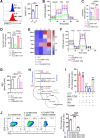Intracellular Acetyl CoA Potentiates the Therapeutic Efficacy of Antitumor CD8+ T Cells
- PMID: 35648389
- PMCID: PMC7613107
- DOI: 10.1158/0008-5472.CAN-21-4052
Intracellular Acetyl CoA Potentiates the Therapeutic Efficacy of Antitumor CD8+ T Cells
Abstract
Effector CD8+ T cells rely primarily on glucose metabolism to meet their biosynthetic and functional needs. However, nutritional limitations in the tumor microenvironment can cause T-cell hyporesponsiveness. Therefore, T cells must acquire metabolic traits enabling sustained effector function at the tumor site to elicit a robust antitumor immune response. Here, we report that IL12-stimulated CD8+ T cells have elevated intracellular acetyl CoA levels and can maintain IFNγ levels in nutrient-deprived, tumor-conditioned media (TCM). Pharmacological and metabolic analyses demonstrated an active glucose-citrate-acetyl CoA circuit in IL12-stimulated CD8+ T cells supporting an intracellular pool of acetyl CoA in an ATP-citrate lyase (ACLY)-dependent manner. Intracellular acetyl CoA levels enhanced histone acetylation, lipid synthesis, and IFNγ production, improving the metabolic and functional fitness of CD8+ T cells in tumors. Pharmacological inhibition or genetic knockdown of ACLY severely impaired IFNγ production and viability of CD8+ T cells in nutrient-restricted conditions. Furthermore, CD8+ T cells cultured in high pyruvate-containing media in vitro acquired critical metabolic features of IL12-stimulated CD8+ T cells and displayed improved antitumor potential upon adoptive transfer in murine lymphoma and melanoma models. Overall, this study delineates the metabolic configuration of CD8+ T cells required for stable effector function in tumors and presents an affordable approach to promote the efficacy of CD8+ T cells for adoptive T-cell therapy.
Significance: IL12-mediated metabolic reprogramming increases intracellular acetyl CoA to promote the effector function of CD8+ T cells in nutrient-depleted tumor microenvironments, revealing strategies to potentiate the antitumor efficacy of T cells.
©2022 The Authors; Published by the American Association for Cancer Research.
Figures






References
Publication types
MeSH terms
Substances
Grants and funding
LinkOut - more resources
Full Text Sources
Medical
Research Materials

